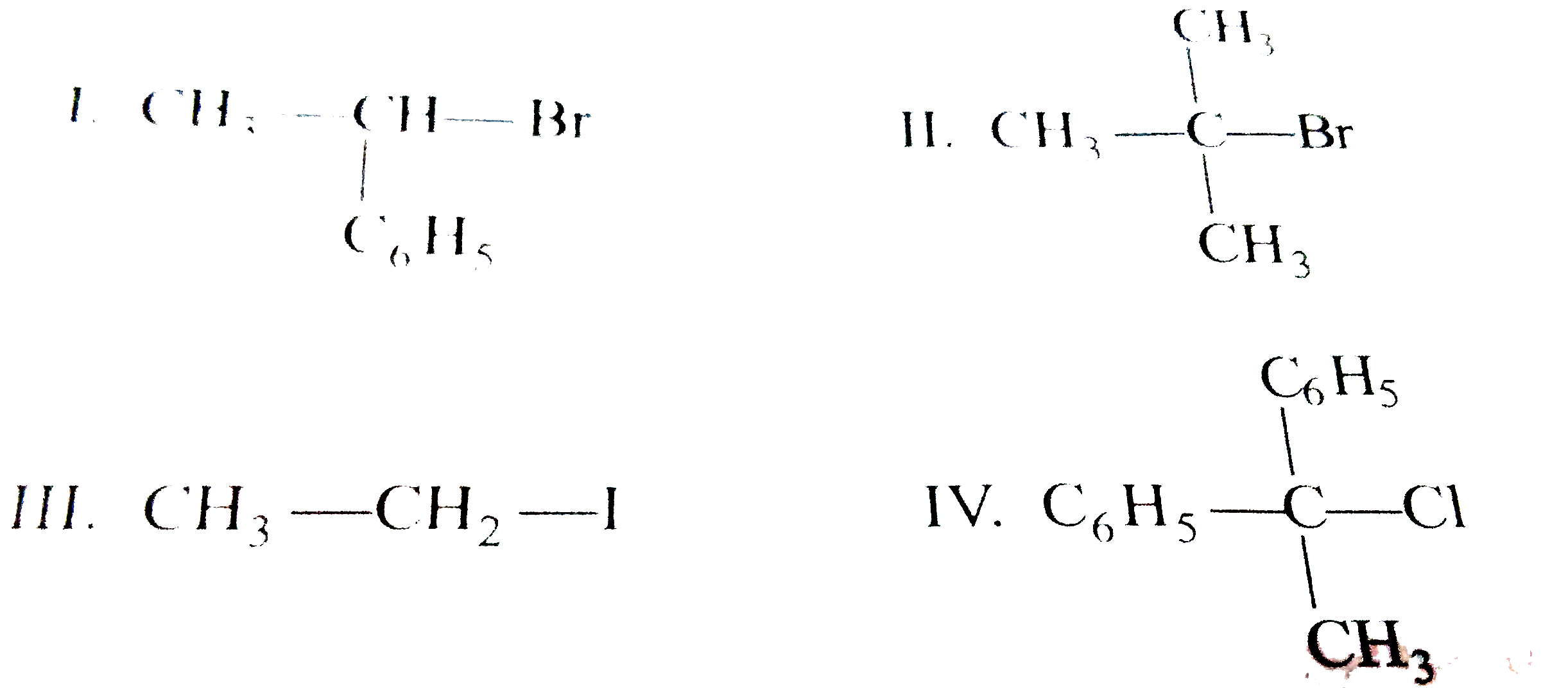During SN1 reactions, the leaving group leaves the molecule before the incoming group is attached to the molecule.
The correct Answer is:1
In SN1, first the ionisation of RX takes place, which means the leaving group leaves the molecule before the attack of NuӪ.
 .
.
Topper's Solved these Questions
- ORGANIC REACTION MECHANISMBOOK - CENGAGE CHEMISTRYCHAPTER - ORGANIC REACTION MECHANISMEXERCISE - Analytical and Descriptive
6 Videos
- ORGANIC REACTION MECHANISMBOOK - CENGAGE CHEMISTRYCHAPTER - ORGANIC REACTION MECHANISMEXERCISE - Archives
8 Videos
- NCERT BASED EXERCISEBOOK - CENGAGE CHEMISTRYCHAPTER - NCERT BASED EXERCISEEXERCISE - Chemical Equilibrium
72 Videos
- P-BLOCK GROUP 13 - BORON FAMILYBOOK - CENGAGE CHEMISTRYCHAPTER - P-BLOCK GROUP 13 - BORON FAMILYEXERCISE - Exercise Archives (Subjecive)
9 Videos
Similar Questions
Leaving Groups || SN2
View SolutionNuclephilic substitution reaction is given by those compounds which have nucleophilic groups as leaving groups. The weaker the basicity of a group of the substrate, the better is its leaving ability.
In nucleophilic substitution reactions, the basicity of leaving group should be less than the incoming nucleophilic group. Nucleophilc substitution reaction at sp3 -hybridised carbon is either bimolecular (SN2) or unimolecular (SN1). Bimolecular reaction takes place in single step, involving transition state intermediate. In SN2 reaction is preferred if the compound has less steric hindrance.
Unimolecular (SN2) reaction involves two steps and carbonium ion intermediate. Optically active substrates give recemic mixture in these reactions.
Which among the following will give SN1 reaction?

View Solution
Knowledge Check
Best leaving group is
AF−BCl−CBr−DI−Which is the best leaving group ?
A−⊕N≡NBOH−CNH−2DCH3COO−Correct order of leaving group tendency is :
AI−>Br−>Cl−>F−BF−>Cl−>Br−>I−CCl−>F−>Br−>I−DI−>Cl−>Br−>F−
Nuclephilic substitution reaction is given by those compounds which have nucleophilic groups as leaving groups. The weaker the basicity of a group of the substrate, the better is its leaving ability.
In nucleophilic substitution reactions, the basicity of leaving group should be less than the incoming nucleophilic group. Nucleophilc substitution reaction at sp3 -hybridised carbon is either bimolecular (SN2) or unimolecular (SN1). Bimolecular reaction takes place in single step, involving transition state intermediate. In SN2 reaction is preferred if the compound has less steric hindrance.
Unimolecular (SN2) reaction involves two steps and carbonium ion intermediate. Optically active substrates give recemic mixture in these reactions.
SN2 reaction involves transition state intermediate, hence it is favoured in which of the following solvents?
View SolutionNuclephilic substitution reaction is given by those compounds which have nucleophilic groups as leaving groups. The weaker the basicity of a group of the substrate, the better is its leaving ability.
In nucleophilic substitution reactions, the basicity of leaving group should be less than the incoming nucleophilic group. Nucleophilc substitution reaction at sp3 -hybridised carbon is either bimolecular (SN2) or unimolecular (SN1). Bimolecular reaction takes place in single step, involving transition state intermediate. In SN2 reaction is preferred if the compound has less steric hindrance.
Unimolecular (SN2) reaction involves two steps and carbonium ion intermediate. Optically active substrates give recemic mixture in these reactions.
Which compound will give Walden inversion in SN2 reaction?
View SolutionNuclephilic substitution reaction is given by those compounds which have nucleophilic groups as leaving groups. The weaker the basicity of a group of the substrate, the better is its leaving ability.
In nucleophilic substitution reactions, the basicity of leaving group should be less than the incoming nucleophilic group. Nucleophilc substitution reaction at sp3 -hybridised carbon is either bimolecular (SN2) or unimolecular (SN1). Bimolecular reaction takes place in single step, involving transition state intermediate. In SN2 reaction is preferred if the compound has less steric hindrance.
Unimolecular (SN2) reaction involves two steps and carbonium ion intermediate. Optically active substrates give recemic mixture in these reactions.
Which among the following will give enantiomeric pair on treatment with HOH?
View SolutionNuclephilic substitution reaction is given by those compounds which have nucleophilic groups as leaving groups. The weaker the basicity of a group of the substrate, the better is its leaving ability.
In nucleophilic substitution reactions, the basicity of leaving group should be less than the incoming nucleophilic group. Nucleophilc substitution reaction at sp3 -hybridised carbon is either bimolecular (SN2) or unimolecular (SN1). Bimolecular reaction takes place in single step, involving transition state intermediate. In SN2 reaction is preferred if the compound has less steric hindrance.
Unimolecular (SN2) reaction involves two steps and carbonium ion intermediate. Optically active substrates give recemic mixture in these reactions.
Select the correct statements among the following:
View Solution−COOH group in electrophilic substitution directs the incoming groups to
View Solution
